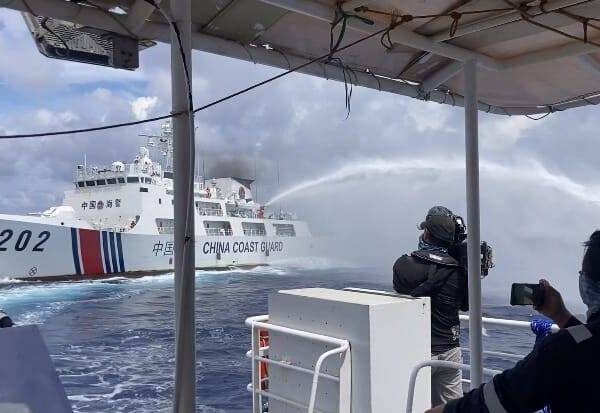Stronger response to China’s bullying

It was, according to a crew member of BRP Datu Sanday who has joined several maritime patrols and been exposed to water cannon attacks by the China Coast Guard (CCG), the “worst” incident he had experienced.
On Sunday, five CCG ships took turns firing water cannons at the vessel operated by the Bureau of Fisheries and Aquatic Resources (BFAR). Not content with that, they also rammed the BFAR vessel six times near Escoda (Sabina) Shoal in the West Philippine Sea (WPS).
The BFAR ship, which suffered engine failure and damage to its starboard and port sides, and its communication and navigational equipment, had to abort its humanitarian operation to bring supplies to Filipino fishermen at Escoda.
Last weekend’s attack was the latest provocation by China’s coast guard and militia vessels.
On Aug. 19, the CCG rammed two Philippine Coast Guard (PCG) ships conducting regular and routine logistics missions in the WPS. Not surprisingly, given China’s overt moves that contradict the supposed “provisional understanding” on the issue between Manila and Beijing, China ascribed the incident to PCG vessels “illegally enter[ing]” the waters of Escoda and ”deliberately” colliding with CCG ships in the shoal. The PCG said it was gathering evidence to debunk this.
Aerial encounter
Aside from blocking, tailing, ramming, and aiming water cannons at BFAR and PCG vessels, China has similarly taken over our country’s airspace, firing several flares on Aug. 22 at a BFAR plane monitoring poachers in the internationally recognized exclusive economic zone (EEZ) of the Philippines. Earlier, on Aug. 19, the same fisheries plane was harassed by a Chinese air force fighter jet, which deployed flares “multiple times” at approximately 15 meters near the disputed Scarborough Shoal, a Philippine task force said.
The first aerial encounter on the territorial dispute occurred on Aug. 8, when two Chinese jets flew dangerously close and fired a volley of flares in the path of a Philippine Air Force patrol plane.
This, on top of the 129 Chinese vessels tracked from Aug. 13 to Aug. 19 across the WPS, and the waters spanning the country’s EEZ in the South China Sea.
Such actions not only “undermine regional peace and security and further erode [China’s] image with the international community,” but also threaten Philippine vessels and aircraft “engaged in legitimate and regular activities within Philippine territory,” the task force said.
‘Act of war’
What’s worse however is how China’s unwarranted aggression has resulted in injuries to Filipinos manning Philippine vessels in the WPS, as in the case of a soldier who lost his thumb after a CCG ship rammed the Armed Forces of the Philippines’ small boat and pointed knives and axes at the crew during a resupply mission to Ayungin Shoal in June.
During a global forum in Manila, also in May, President Marcos warned that, “if by a willful act” a Filipino is killed in the WPS, it would be “very close” to an “act of war,” that could trigger Manila to invoke the Mutual Defense Treaty with the United States.
At the rate that China has been jacking up its unlawful and dangerous maneuvers, that is a real possibility that must be preempted posthaste. Why wait for a Filipino fatality when all manner of diplomatic protests, dialogue, and bilateral agreements have proven ineffective, with China blatantly ignoring them?
Clearly, stronger moves are in order to deter China’s bullying tactics. Continuing a beefed up patrol of disputed areas, and holding regular war games with allied countries are a good start, while Defense Secretary Gilberto Teodoro’s suggestion for us to look into a wider interpretation of the country’s defense pact with the US bears serious study.
Weighty decision
But while the US is open to escorting Philippine vessels on its rotation and resupply mission, Armed Forces chief Gen. Romeo Brawner Jr. cautioned that this could run afoul of the country’s constitutional ban on foreign forces directly joining local combat operations. Commendably, he maintained that the Philippines would “first rely on [itself, and] try all options … [until] we are already constrained from doing it ourselves.”
One option that the National Maritime Council floated last Aug. 20 is the possibility of the Philippines filing a case against China before different bodies, given that its extensive claim of sovereignty over almost the entire South China Sea, has already been invalidated by the Permanent Court of Arbitration in 2016.
China’s warlike actions are also a gross violation of international law, specifically, the United Nations Convention on the Law of the Sea and the 1972 Convention on International Regulations for Preventing Collisions at Sea.
It’s a weighty decision that Mr. Marcos must seriously look into, given that he has the “last word” on any legal action on West Philippine Sea issues. It’s an option that’s bound to earn global support as it upholds a rules-based order and the peaceful settlement of disputes based on international law.

















